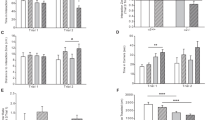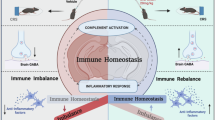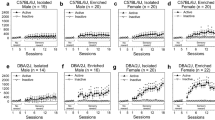Abstract
The present experiments characterized the acquisition of fear-potentiated startle (FPS) and determined the sensitivity of FPS to anxiolytic compounds in DBA/1J mice. A light (30 s) conditioned stimulus (CS) and mild footshock (0.14 mA, 0.5 s) unconditioned stimulus (US) were used. First, acquisition of FPS was examined by presenting the acoustic startle probe during and after each CS–US pairing trial, allowing for a trial-by-trial measurement of experience-dependent startle plasticity. In this novel protocol, mice showed robust acquisition (larger acoustic startle reflex in the presence of the CS) of FPS after as few as eight CS–US pairings. FPS was significantly greater when the CS and US were paired explicitly (light-paired) as compared to when both the US and CS were presented randomly (unpaired), or when the CS was presented alone (no shock), indicating pairing-dependent learning of the CS. Second, the present study assessed the sensitivity of FPS in mice to anxiolytic drugs. The GABA-A receptor agonists diazepam (3 and 6 mg/kg) and chlordiazepoxide (10 mg/kg) significantly reduced the expression of FPS post-training, as did the serotonin 1A receptor partial agonist buspirone (5 and 10 mg/kg). Furthermore, all three anxiolytic drugs reduced startle responding in a cue-specific manner and without significant changes in baseline responding. These data demonstrate a novel method of studying acquisition of FPS, and support the predictive validity of the FPS model of anxiolytic drug action in mice.
Similar content being viewed by others
Log in or create a free account to read this content
Gain free access to this article, as well as selected content from this journal and more on nature.com
or
References
Argyropoulos SV, Sandford JJ, Nutt DJ (2000). The psychobiology of anxiolytic drugs. Part 2: pharmacological treatments of anxiety. Pharmacol Ther 88: 213–227.
Baas JM, Grillon C, Bocker KB, Brack AA, Morgan CA, Kenemans JL et al (2002). Benzodiazepines have no effect on fear-potentiated startle in humans. Psychopharmacology 161: 233–247.
Bitsios P, Philpott A, Langley RW, Bradshaw CM, Szabadi E (1999). Comparison of the effects of diazepam on the fear-potentiated startle reflex and the fear-inhibited light reflex in man. J Psychopharmacol 13: 226–234.
Brown JS, Kalish HI, Farber IE (1951). Conditional fear as revealed by magnitude of startle response to an auditory stimulus. J Exp Psychol 41: 317–328.
Butler RW, Braff DL, Rausch JL, Jenkins MA, Sprock J, Geyer MA (1990). Physiological evidence of exaggerated startle response in a subgroup of Vietnam veterans combat-related PTSD. Am J Psychiatry 147: 1308–1312.
Crawley JN, Belknap JK, Collins A, Crabbe JC, Frankel W, Henderson N et al (1997). Behavioral phenotypes of inbred mouse strains: implications and recommendations for molecular studies. Psychopharmacology 132: 107–124.
Davis M (1989). Sensitization of the acoustic startle reflex by footshock. Behav Neurosci 103: 495–503.
Davis M (1992). The role of the amygdala in fear and anxiety. Annu Rev Neurosci 15: 353–375.
Davis M (1998a). Are different parts of the extended amygdala involved in fear versus anxiety? Biol Psychiatry 44: 1239–1247.
Davis M (1998b). Anatomic and physiologic substrates of emotion in an animal model. J Clin Neurophysiol 15: 378–387.
Davis M, Cassella JV, Kehne JH (1988). Serotonin does not mediate anxiolytic effects of buspirone in the fear-potentiated startle paradigm: comparison with 8-OH-DPAT and ipsapirone. Psychopharmacology 94: 14–20.
Davis M, Falls WA, Campeau S, Kim M (1993). Fear-potentiated startle: a neural and pharmacological analysis. Behav Brain Res 58: 175–198.
de Jongh R, Groenink L, van Der Gugten J, Olivier B (2002). The light-enhanced startle paradigm as a putative animal model for anxiety: effects of chlordiazepoxide, flesinoxan and fluvoxamine. Psychopharmacology 159: 176–180.
Dulawa SC, Geyer MA (1996). Psychopharmacology of prepulse inhibition in mice. Chin J Physiol 39: 139–146.
Dulawa SC, Grandy DK, Low MJ, Paulus MP, Geyer MA (1999). Dopamine D4 receptor-knockout mice exhibit reduced exploration of novel stimuli. J Neurosci 19: 9550–9556.
Falls WA, Carlson S, Turner JG, Willott JF (1997). Fear-potentiated startle in two strains of inbred mice. Behav Neurosci 111: 855–861.
Falls WA, Kogan JH, Silva AJ, Willott JF, Carlson S, Turner JG (2000). Fear-potentiated startle, but not prepulse inhibition of startle, is impaired in CREBalphadelta−/− mutant mice. Behav Neurosci 114: 998–1004.
Fendt M, Fanselow MS (1999). The neuroanatomical and neurochemical basis of conditioned fear. Neurosci Biobehav Rev 23: 743–760.
Gingrich JA, Hen R (2001). Dissecting the role of the serotonin system in neuropsychiatric disorders using knockout mice. Psychopharmacology 155: 1–10.
Griebel G, Belzung C, Perrault G, Sanger DJ (2000). Differences in anxiety-related behaviours and in sensitivity to diazepam in inbred and outbred strains of mice. Psychopharmacology 148: 164–170.
Grillon C, Ameli R, Goddard A, Woods SW, Davis M (1994). Baseline and fear-potentiated startle in panic disorder patients. Biol Psychiatry 35: 431–439.
Grillon C, Ameli R, Woods SW, Merikangas K, Davis M (1991). Fear-potentiated startle in humans: effects of anticipatory anxiety on the acoustic blink reflex. Psychophysiology 28: 588–595.
Grillon C, Dierker L, Merikangas KR (1998). Fear-potentiated startle in adolescent offspring of parents with anxiety disorders. Biol Psychiatry 44: 990–997.
Grillon C, Morgan III CA (1999). Fear-potentiated startle conditioning to explicit and contextual cues in Gulf War veterans with posttraumatic stress disorder. J Abnorm Psychol 108: 134–142.
Groenink L, Joordens RJ, Hijzen TH, Dirks A, Olivier B (2000). Infusion of flesinoxan into the amygdala blocks the fear-potentiated startle. Neuroreport 11: 2285–2288.
Guscott MR, Cook GP, Bristow LJ (2000). Contextual fear conditioning and baseline startle responses in the rat fear-potentiated startle test: a comparison of benzodiazepine/gamma-aminobutyric acid-A receptor agonists. Behav Pharmacol 11: 495–504.
Hamm AO, Greenwald MK, Bradley MM, Lang PJ (1993). Emotional learning, hedonic change, and the startle probe. J Abnorm Psychol 102: 453–465.
Heldt S, Sundin V, Willott JF, Falls WA (2000). Posttraining lesions of the amygdala interfere with fear-potentiated startle to both visual and auditory conditioned stimuli in C57BL/6J mice. Behav Neurosci 114: 749–759.
Ison JR, Hammond GR (1971). Modification of the startle reflex in the rat by changes in the auditory and visual environments. J Comp Physiol Psychol 75: 435–452.
Kim M, Davis M (1993). Electrolytic lesions of the amygdala block acquisition and expression of fear-potentiated startle even with extensive training but do not prevent reacquisition. Behav Neurosci 107: 580–595.
LaBar KS, Gatenby JC, Gore JC, LeDoux JE, Phelps EA (1998). Human amygdala activation during conditioned fear acquisition and extinction: a mixed-trial fMRI study. Neuron 20: 937–945.
Lang PJ, Davis M, Ohman A (2000). Fear and anxiety: animal models and human cognitive psychophysiology. J Affect Disord 61: 137–159.
Leaton RN, Cranney J (1990). Potentiation of the acoustic startle response by a conditioned stimulus paired with acoustic startle stimulus. J Exp Psychol 16: 279–287.
LeDoux J (2000). Emotion circuits in the brain. Annu Rev Neurosci 23: 155–184.
Lister RG (1987). The use of a plus-maze to measure anxiety in the mouse. Psychopharmacology 92: 180–185.
Low K, Crestani F, Keist R, Benke D, Brunig I, Benson JA et al (2000). Molecular and neuronal substrate for the selective attenuation of anxiety. Science 290: 131–134.
Mansbach RS, Geyer MA (1988). Blockade of potentiated startle responding in rats by 5-hydroxytryptamine1A receptor ligands. Eur J Pharmacol 156: 375–383.
McCaughran Jr JA, Bell J, Hitzemann III RJ (2000). Fear-potentiated startle response in mice: genetic analysis of the C57BL/6J and DBA/2J intercross. Pharmacol Biochem Behav 65: 301–312.
McNish KA, Gewirtz JC, Davis M (1997). Evidence of contextual fear after lesions of the hippocampus: a disruption of freezing but not fear-potentiated startle. J Neurosci 17: 9353–9360.
Melia KR, Davis M (1991). Effects of septal lesions on fear-potentiated startle, and on the anxiolytic effects of buspirone and diazepam. Physiol Behav 49: 603–611.
Menard J, Treit D (1999). Effects of centrally administered anxiolytic compounds in animal models of anxiety. Neurosci Biobehav Rev 23: 591–613.
Moldin S (2000). Neurobiology of anxiety and fear: challenges for genomic science of the new millennium. Biol Psychiatry 48: 1144–1146.
Morgan III CA, Grillon C, Southwick SM, Davis M, Charney DS (1996). Exaggerated acoustic startle reflex in Gulf War veterans with posttraumatic stress disorder. Am J Psychiatry 153: 64–68.
Patrick CJ, Berthot BD, Moore JD (1996). Diazepam blocks fear-potentiated startle in humans. J Abnorm Psychol 105: 89–96.
Phelps EA, O'Connor KJ, Gatenby JC, Gore JC, Grillon C, Davis M (2001). Activation of the left amygdala to a cognitive representation of fear. Nat Neurosci 4: 437–441.
Richardson R (2000). Shock sensitization of startle: learned or unlearned fear? Behav Brain Res 110: 109–117.
Satcher D (1999). In: Goldman HH, Rye P, Sirovatka P (eds). US Mental Health: A Report of the Surgeon General. US Department of Health and Human Services: Rockville.
Shekhar A, McCann UD, Meaney MJ, Blanchard DC, Davis M, Frey KA et al (2001). Summary of a National Institute of Mental Health workshop: developing animal models of anxiety disorders. Psychopharmacology 157: 327–339.
Spence KW, Runquist WN (1958). Temporal effects of conditioned fear on the eyelid reflex. J Exp Psychol 55: 613–616.
Stiedl O, Misane I, Spiess J, Ogren SO (2000). Involvement of the 5-HT1A receptors in classical fear conditioning in C57BL/6J mice. J Neurosci 20: 8515–8527.
Walker DL, Davis M (1997). Double dissociation between the involvement of the bed nucleus of the stria terminalis and the central nucleus of the amygdala in startle increases produced by conditioned versus unconditioned fear. J Neurosci 17: 9375–9383.
Walker DL, Davis M (2000). Involvement of NMDA receptors within the amygdala in short- versus long-term memory for fear conditioning as assessed with fear-potentiated startle. Behav Neurosci 114: 1019–1033.
Acknowledgements
These studies were supported by a grant from the National Institute on Drug Abuse (DA02925), the MERCK NEP fellowship and by the Veterans Affairs VISN 22 Mental Illness Research, Education, and Clinical Center. We thank Richard Sharp and Jonathon Stroebel for their excellent technical assistance. We thank Dr Susan Powell for her helpful comments during these studies and in the writing of this manuscript. MA Geyer holds an equity interest in San Diego Instruments.
Author information
Authors and Affiliations
Corresponding author
Rights and permissions
About this article
Cite this article
Risbrough, V., Brodkin, J. & Geyer, M. GABA-A and 5-HT1A Receptor Agonists Block Expression of Fear-Potentiated Startle in Mice. Neuropsychopharmacol 28, 654–663 (2003). https://doi.org/10.1038/sj.npp.1300079
Received:
Revised:
Accepted:
Published:
Issue date:
DOI: https://doi.org/10.1038/sj.npp.1300079
Keywords
This article is cited by
-
Pharmacological modulation of conditioned fear in the fear-potentiated startle test: a systematic review and meta-analysis of animal studies
Psychopharmacology (2023)
-
Inhibition of serotonin transporters disrupts the enhancement of fear memory extinction by 3,4-methylenedioxymethamphetamine (MDMA)
Psychopharmacology (2017)
-
Novel drug-regulated transcriptional networks in brain reveal pharmacological properties of psychotropic drugs
BMC Genomics (2013)
-
The brain orexin system and almorexant in fear-conditioned startle reactions in the rat
Psychopharmacology (2012)
-
Convergent functional genomics of anxiety disorders: translational identification of genes, biomarkers, pathways and mechanisms
Translational Psychiatry (2011)



